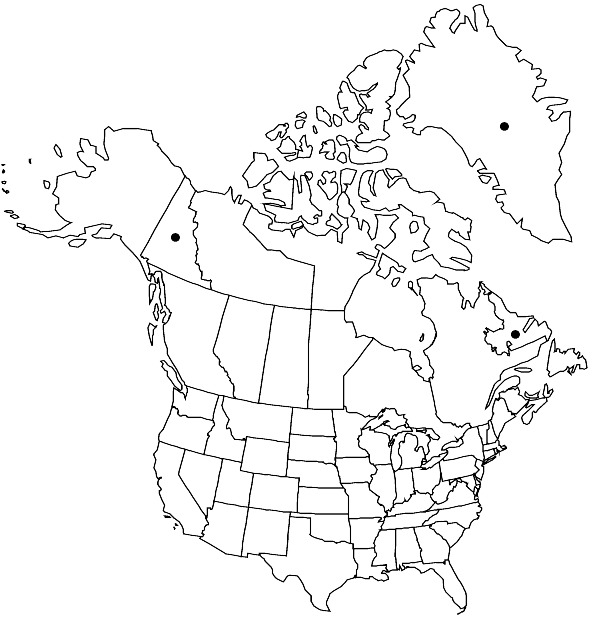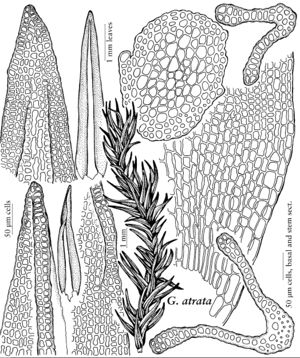Difference between revisions of "Grimmia atrata"
Flora 2: 85. 1819,.
FNA>Volume Importer |
FNA>Volume Importer |
(No difference)
| |
Revision as of 21:52, 16 December 2019
Plants in variable loose patches, dark green to black, frequently rust colored proximally. Stems 2–7 cm, central strand absent. Leaves lanceolate to ligulate, 1.5–3 × 0.3–0.6 mm, keeled, margins recurved proximally, incurved distally, tapering to a blunt cucullate apex, muticous, costal transverse section prominent, usually semicircular; basal juxtacostal laminal cells rectangular, straight to slightly sinuose walled; basal marginal laminal cells in 1–3 rows quadrate, hyaline with straight to slightly sinuose, thick transverse walls; medial laminal cells rectangular, nearly straight to sinuose or nodulose, thick-walled; distal laminal cells 1-stratose with 2-stratose ridges, to completely 2-stratose. Sexual condition dioicous, perichaetial leaves not enlarged. Seta straight, 2–6 mm. Capsule occasionally present, long-exserted, yellow-brown, oblong to cylindric, exothecial cells rectangular, thick-walled, annulus of 3–4 rows of rectangular, thick-walled cells, stomata present, operculum conic to rostrate, peristome present, fully-developed, perforated and split distally, weakly papillose.
Habitat: Damp, heavy-metal-bearing rock from the lowlands to the alpine
Elevation: moderate to high elevations (1100-2600 m)
Distribution

Greenland, Nfld. and Labr. (Labr.), Yukon, South America (Bolivia), Eurasia.
Discussion
Of conservation concern.
Grimmia atrata is rare in North America, being known only from three widely scattered areas. It is known to geologists as one of the “copper-mosses,” i.e., it is an indicator of heavy-metal-bearing rock. Because it prefers damp gneiss and mica schists, the tufts are often orange inside on account of the presence of heavy-metal oxides. The placement of G. atrata has been problematic. Because of the curved distal leaves and the absence of awns, it does not immediately appear to be a Grimmia. As a result it has previously been placed in a separate genus, Dryptodon, intermediate between Grimmia and Racomitrium. Following Cao T. and D. H. Vitt (1986b), Hastings placed it in subg. Guembelia based on its thick, keeled leaves, long, straight setae, and smooth capsules. With its recurved margin, rectangular, thick-walled, sometimes sinuous basal laminal cells, prominent annulus, and mitrate calyptra, it would seem closest to the group including G. longirostris and G. pilifera. However, its large size and muticous, cucullate leaves, which are often ligulate, coupled with its preference for moist habitats, readily separate this species from other members of this group. Sterile specimens with 1-stratose laminae may be confused as belonging to the subg. Rhabdogrimmia. In densely shaded habitats, it grows in loose patches and the areolation shows a near absence of sinuosity. On dry rock, however, the plants have extremely thick, nodulose cell walls that place the species firmly in Grimmia.
Selected References
None.
